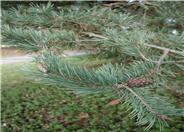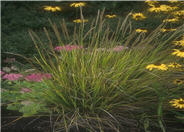
Common name:White Birch, European White Birch
Botanical name:Betula pendula
This medium-size weeping tree will grow to about 40' tall and has a whitish/brown bark with deciduous green leaves.

Common name:Scotch Pine
Botanical name:Pinus sylvestris
Some features of the Pinus sylvestris include its stout, twisted needles and egg-shaped cones. Its trunk is often straight; the bark, which peels in irregular plates, is a purple gray color which changes to orange and flaking toward the top. Positive growth will result from planting in acidic, well-drained soil. It is best to destroy severely beetle-ridden trees. Pines are highly combustible plants.

Common name:Cloth of Gold Yarrow
Botanical name:Achillea 'Moonshine'
Long, straight stems with pale yellow flowers are apparent on the mats of green to grey-green leaves of this plant, which are flatter and less divided than those of the Achillea millefolium.
The yarrow propagate easily from rooted cuttings or division, which should be performed in the early spring or fall. Following bloom, one should dead head the plant and divide the clumps when it appears crowded.

Common name:Tall Moor Witch Grass
Botanical name:Molinia caerulea 'Moorehexe'
Molinia caerulea 'Moorehexe' is a perennial grass. Plants live long but grow slow. Leaves are light green, narrow, in neat dense clumps 1-2 ft. tall and wide. In summer, yellowish to purplish flowers in narrow, spikelike clusters rise 2-3 ft. above clumps.

Common name:Butterfly Bush, Summer Lilac
Botanical name:Buddleja davidii
Butterfly bush is a fast growing deciduous or semi-evergreen shrub ranging from 3' up to 10', with an open, rangy growth habit. It should be cut back nearly to the ground in fall for size control and appearance. Purple, pink, white or red flowers appear in spring and summer, attracting butterflies. Sterile varieties are required in Oregon because of invasive issues. Use 'Asian Moon','Blue Chip', or 'Purple Haze' for example.
Photographer: GardenSoft
Practice grass-cycling by leaving short grass clippings on lawns after mowing, so that nutrients and organic matter are returned to the soil.
Drip and other smart irrigation delivers water directly to roots, allowing no excess water for weeds.